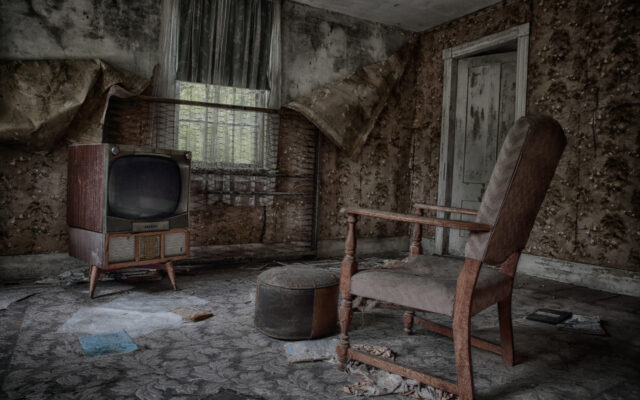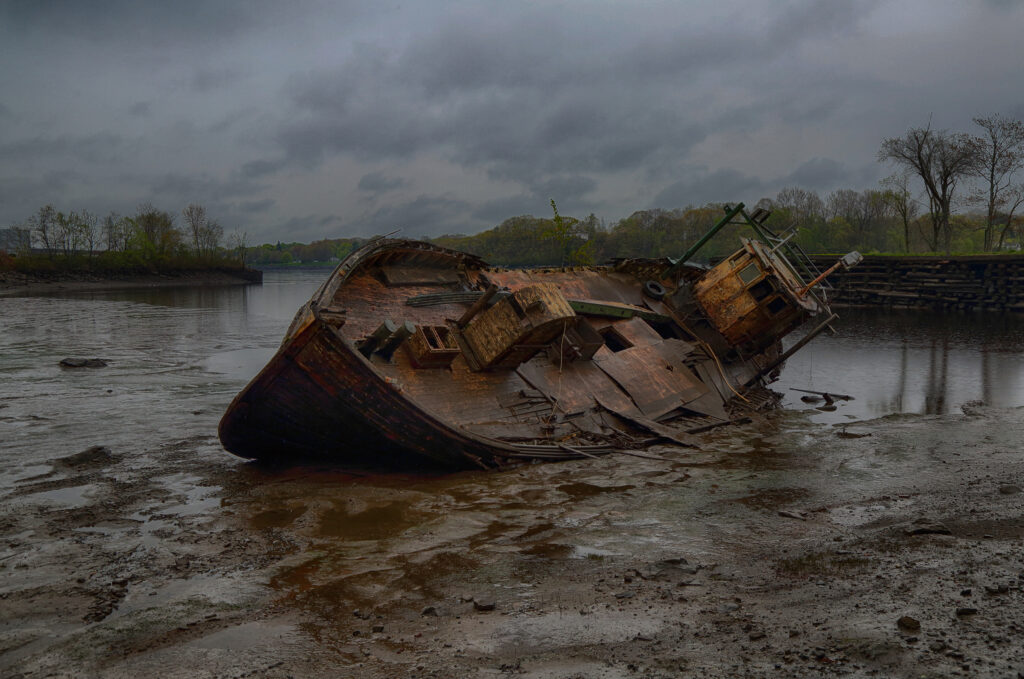
Photographer finds the spooky beauty in Maine’s abandoned places
By Troy Bennett, Bangor Daily News Staff
Maine photographer Arend T. Thibodeau has a thing for dilapidation. That’s why Thibodeau has spent the last ten years crisscrossing the state photographing abandoned houses, crumbling factories and other structures well on their way to historic oblivion.
He’s half-motivated by a desire to document these places before it’s too late.
“The other 50 percent is taking the decay, filth, degradation and turning it into something beautiful,” Thibodeau said. “The way natural light falls on these places — if you capture it correctly, you really own something.”

FORGOTTEN PLACES — A chair sits facing an old television inside an abandoned house in an image by Maine photographer Arend T. Thibodeau. The Harmony-based artist has just published two books picturing some of the state’s forgotten rural places and structures.
Now, after a decade of shooting, he’s published two slim-but-comprehensive photo books dedicated to what he found when peering at Maine’s forsaken rural landscapes. “Residential Ruins of Maine” and “Forgotten Industry and Institutions of Maine” are both available through Arcadia Publishing’s America Through Time imprint.
“Residential Ruins of Maine” is dedicated to houses, farms and hunting cabins. In its pages, Thibodeau presents quiet photos of buildings — inside and out — lost in time.
Clapboarded abodes peek out from behind green vines and shrubs as the wilderness reclaims them. Other old houses stand askew and naked on snow-covered fields. A few are nothing but hollowed-out shells with trees growing through their roofs.

FORGOTTEN VESSEL — A forgotten fishing vessel languishes in Penobscot River mud in an image by Maine photographer Arend T. Thibodeau. The Harmony-based artist has just published two books picturing some of the state’s forgotten rural places and structures.
But Thibodeau also takes his lens further, inside these buildings, revealing what you can’t see from the road. An ancient chair and footstool sit opposite an old-fashioned console television, its screen likely dark for decades. A wall clock reads 20 minutes until nine, maybe forever. A mirthless Christmas tree stands in a corner, devoid of gifts.
Thibodeau’s second book, “Forgotten Industry and Institutions of Maine,” takes an equally in-depth look at non-residential locations and objects. Here, the Harmony-based photographer finds unlikely beauty in rusting railcars, deteriorating work trucks and looming brick smokestacks.
In one set of photos, Thibodeau explores a shuttered clothespin factory, its floor strewn with the once ubiquitous domestic objects made from Maine trees. Many of the machines appear as if they could spring back to work at any moment. In another picture collection, the photographer takes viewers inside an abandoned jail slathered with multiple layers of peeling paint. Several more pages are dedicated exclusively to church exterior and interiors.

CRUMBLING STAIRCASE — A crumbling staircase and forgotten note appear in images by Maine photographer Arend T. Thibodeau. The Harmony-based artist has just published two books picturing some of the state’s forgotten rural places and structures.
When photographing these private places, Thibodeau follows a personal set of rules.
“I take only pictures, and I leave only footprints,” he said.
Plus, to help prevent graffiti, looting and vandalism, Thibodeau is tight-lipped about where he finds most of his subjects. He does admit that he is sometimes, technically, trespassing when he makes his photos. But Thibodeau has a clause in his personal code of ethics for that, too.
“I would never break in or force myself into any of these places,” he said. “There’s got to be a very visible way in and out.”
If there’s no obvious opening, Thibodeau tries to find an owner who will unlock the door for him.
Many of the interior photos drip with a real sense of silent foreboding. With decaying household objects frozen in grungy time, as if families left in a hurry, it’s easy to imagine unfriendly spirits keeping watch. Thibodeau writes about a few uncanny experiences he’s had while making pictures, including mysterious footsteps, faint voices and a gauzy pink dress on a hanger he once mistook for an apparition.
“I tried to write in such a way so it leaves the jury out — if you want to believe in the supernatural, I don’t want to take that away from you. But if you’re a skeptic, I want to allow you to be a skeptic as well,” he said. “A lot of times you get in these places and you hear a noise and it’s just your imagination running wild. I have had some experiences. What exactly they are, I can’t tell you.”
Though he’s just published two new books, Thibodeau has already filed another manuscript with his publisher.
“It’s about Maine cemeteries,” he said, “and it should be out next year.”